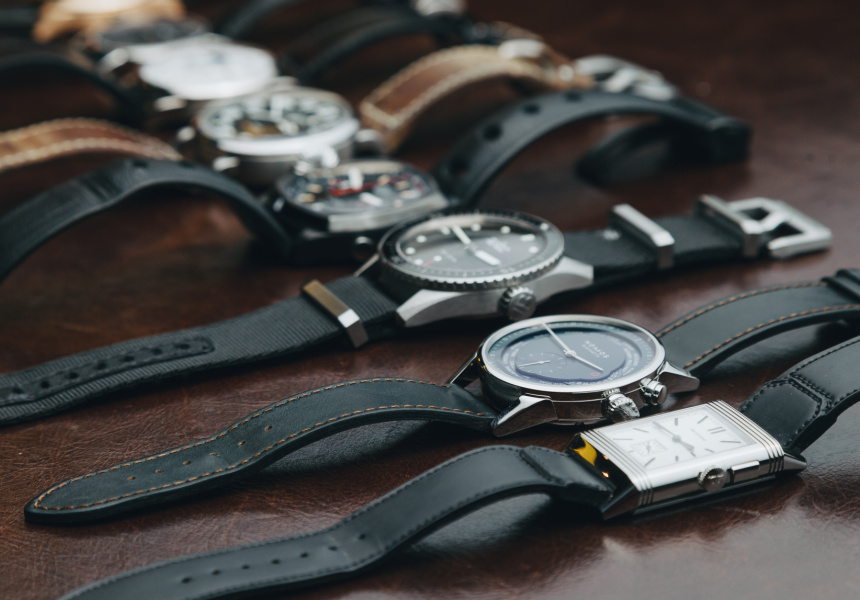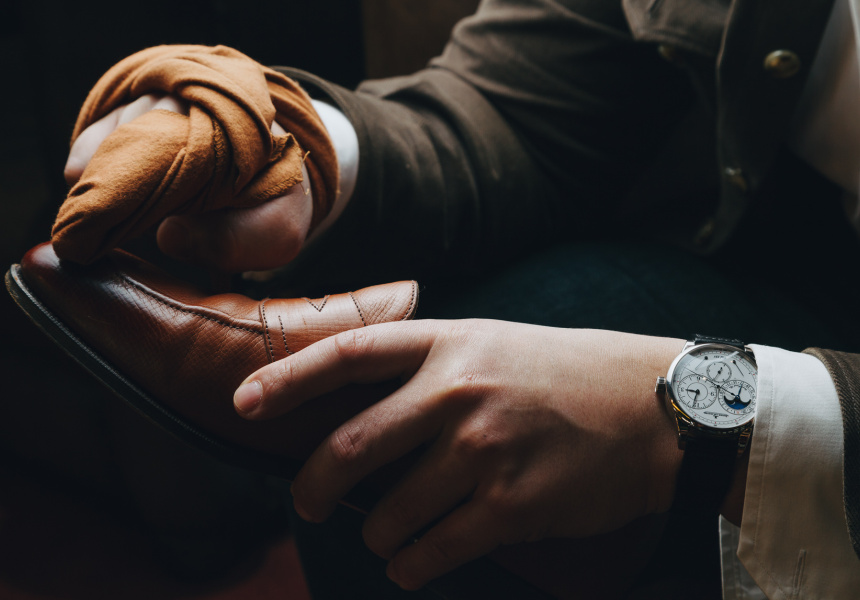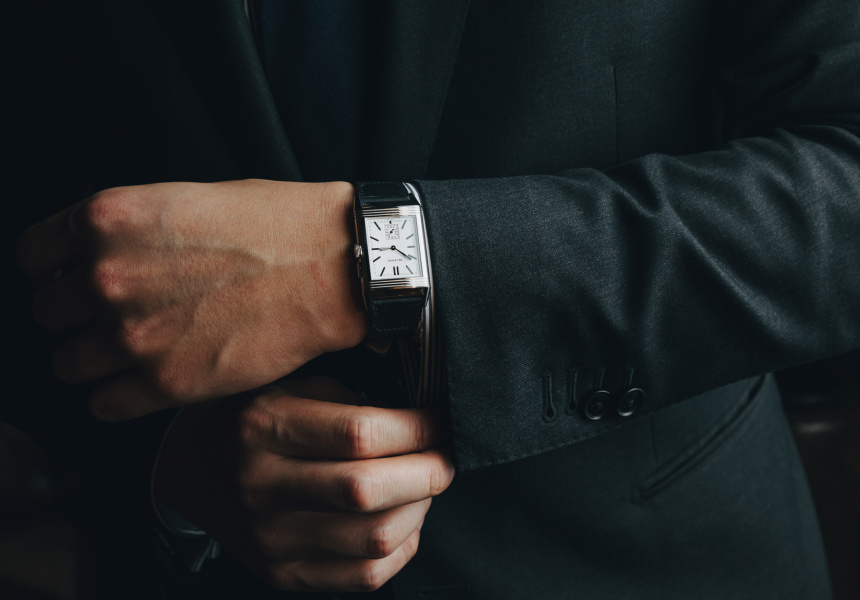Chris Schaerf and Charles Tutton run Double Monk, a high-end shoe store on Smith Street, Fitzroy. “Shoe store” is a misnomer – Double Monk offers a rare, high-end experience, from the gorgeous floor-to-ceiling displays of hard-to-find premium shoes sourced from all over the world, to a fully stocked bar and leather armchairs, alongside complementary items like Rubinacci ties, Corgi socks, Marvis toothpaste, and Fox umbrellas.
With such pedigree, it’s no surprise the store’s curators are well-schooled in the art of high-quality timepieces. “All of us at Double Monk have one good watch, many of us have several, and several of us have many,” says Tutton. “Our customers often have an interest in watches and watches are a frequent topic of conversation in the shop.”
Schaerf’s collection began early. Given a Swatch for his eighth birthday, he’s worn a watch every day since – albeit each becoming substantially more coveted than the first. “I find them useful and aesthetically pleasing,” he says. "They’re a fundamental instrument and take an enormous amount of skill and workmanship to make.” Tutton concurs: “They’re nice to look at. You wear them on your skin like underwear, but they’re also expensive mechanical jewellery.
Never miss a moment. Make sure you're subscribed to our newsletter today.
SUBSCRIBE NOWTutton says like luxury shoes, the endurance of watches as a fashion item has as much to do with telegraphing status as it does function.
“You don’t need to do anything to own a watch,” he says. “You don’t need any skills, extra time, or practice. You don’t need to have a particular lifestyle. You can wear it all the time, every day.”
What you do need though is some cash – there's a price for the intimacy. “Watches are personal items, much like the things we sell at Double Monk,” says Tutton. “They're relatively expensive but materially substantial. Form, construction and function are the cornerstones of the shoe brands we sell, and this is true of the great watch brands.”
But with “good” watches ranging from $5000 to priceless, what should you look for when choosing a watch?
Andrew McUtchen is the founder of watch publication Time+Tide and an expert on the machinations of watches and their value.
With “more than 10 but less than 15” high-end watches in his personal collection, McUtchen says a quality watch is the perfect antidote to the disease of disposable fashion. “It’s about passing things on to your children,” he says. “It’s about not throwing things out. If you buy a Cartier or a Rolex, 40 years later it will still have meaning. It won’t have been superseded.”
We asked McUtchen and the Double Monk team to share tips on buying a quality timepiece that will last a lifetime.
Designed for purpose
McUtchen says begin by looking at styles you like, then see if they fit your intended function.
Most designs are derived from their originally intended purpose. Dress watches, designed for formal occasions, are elegant but less robust and versatile for day-to-day wear, while water-resistant dive watches are often chunky to survive pressure up to 300 metres below the surface. Automotive-themed watches often feature perforated straps and chronographs (a combination watch that displays the time and operates as a stopwatch), while aviation watches are distinguished by a “clear and legible” look. “They are meant to be read at a glance by a pilot,” says McUtchen. “So they have a really lovely timeless aesthetic appeal because they don’t have a lot of visual clutter.”
You don’t have to be a pilot to buy an aviation watch. But which one you choose should depend on what you want to use it for. “If you find yourself saying ‘I just want a good watch to wear all the time’, you have to think about what watch will be versatile,” says McUtchen. He suggests a watch with a changeable strap that allows you to wear it in a range of different occasions.
Know your budget and materials
Decide how much you can afford – there will always be a watch out of your budget. McUtchen says a tip for the newcomer is knowing some watches use the same movement [the internal mechanism that makes a watch work], irrespective of price. “Brands trade off their cachet,” McUtchen says. “Meaning you’re not always getting what you pay for in terms of hardware.”
There are several major groups in the watch industry that house large stables of brands, ranging in quality from basic to prestige. “They share movements and yet the price points across their brands are wildly different,” says McUtchen, who claims it’s possible to pay $1000–$1500 for a watch that uses the same movement as a $5000–$6000 watch by the same brand.
Before you splurge, a good rule of thumb is to do some research: check if one movement is present in other examples of the brand. “Usually you’ll find that what differs is just the logo on the dial,” says McUtchen.
Back at Double Monk, Tutton points out that materials matter. The two most widely used metals in watches are gold and steel. “With new steel models you have to get something very collectible, otherwise you’ll lose a lot of money if you ever wish to sell it,” says Tutton. “Buying a new steel watch with some expensive technical gadgetry in it is likely to be a bad investment. Better buying a late model Rolex Daytona or an older collectible GMT-Master or Submariner.”
Where to buy
Where you find a quality watch depends on how secure you want the purchase to be, says McUtchen. There are three main options available to quality watch buyers: standard retail, second-hand, and “the grey market,” a network of online resellers that he considers risky to use.
High-end watches are delicate machines frequently exposed to wear and tear. Buying from a retailer or a brand boutique ensures a warranty and access to a service centre. This kind of purchase is the “start of a relationship,” says McUtchen. “You’ll pay more, but you’ll have peace of mind.”
Second-hand watches can be cheaper, but lack the after-sales support that comes with standard retail.
After-sales service
Once purchased, McUtchen says it’s important to view your watch for what it is: a machine. “There is as many moving parts in a car as in a modern watch,” says McUtchen. Like a car, a watch will require maintenance. “As much as it hurts to spend $1400 on a Rolex service every five years, it will guarantee it stays accurate and keeps ticking,” he says. “If you just let it run for 40 years without a service, accuracy drops and it won’t function as well. So you need to factor in that cost.”
And is there anything to know about collecting high-quality watches people might not realise before they begin? The guys at Double Monk have some wisdom. “You can end up having a lot of watches as they’re easy to store and there’s endless variety,” says Tutton. “But you can really only ever wear one at a time. The less you wear it, the less it’s really yours.”
Schaerf offers another problem. “You think you’ll buy one good watch and be satisfied,” he warns. “However the next watch is just around the corner.”
Watches provided by Monards.
This article is produced by Broadsheet in partnership with Wild Turkey Master’s Keep premium bourbon. Only the third exclusive release and limited to 10,000 bottles in Australia, the Master’s Keep premium series has been hand selected by master distiller Eddie Russell.




